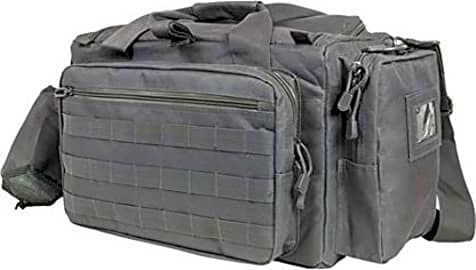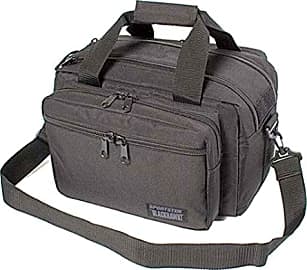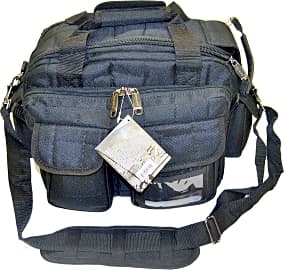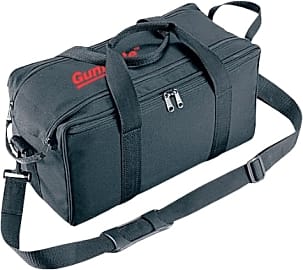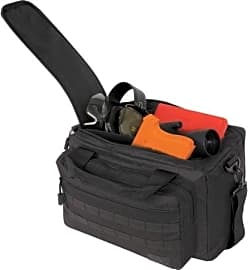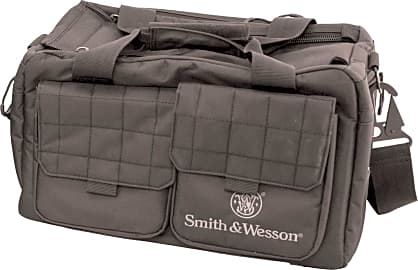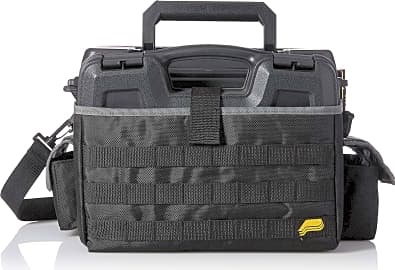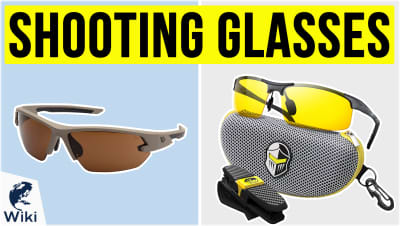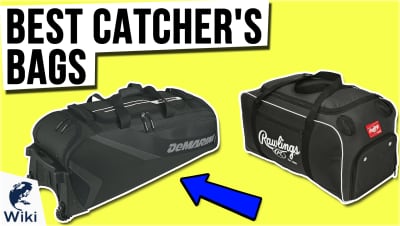The 10 Best Shooting Range Bags

This wiki has been updated 35 times since it was first published in December of 2016. A day at a shooting range requires quite a bit of gear and a smart way to organize it. These bags come with specially-designated slots for essentials, like ammunition; easily accessible pockets, so you can swap out a weapon or reload quickly; and extra room for your keys, wallet, and phone. We made sure all our picks were rugged enough to last through years of use. When users buy our independently chosen editorial picks, we may earn commissions to help fund the Wiki.
Editor's Notes
April 17, 2019:
The 5.11 Outdoor Tactical maintained its position atop our list, as it's one of the most versatile options on the market. Groups will appreciate how it has enough space to accommodate a wide range of gear, while single users will enjoy the removable tote that enables them to lug around only the bare necessities for the day.
The Glock Perfection was omitted from this iteration; we included it in previous lists because it was useful for beginners, even if it wasn't terribly durable. We feel that there are currently several other options available that are inexpensive enough that rookies can easily afford them (like the GunMate 1919687, for example) while still offering quality superior to that boasted by the Perfection.
We added the Smith & Wesson M&P Recruit because we believe it's a smart choice for users who frequent outdoor ranges. It's capable of standing up to inclement weather, and it's easy to empty or fill up in a hurry, allowing you to bail out if the weather gets too formidable.
The History Of Shooting As A Sport
At the time, these clubs were limited to male members only and made use of bows and wheel-lock muskets.
Shooting practice may have once only been for military training, but as early as the 8th century B.C.E., Homer's Iliad mentions Greeks holding archery contests to honor the gods. It is believed that Indians and Persians of the time also held similar contests. By the 10th century B.C.E., marksmanship had already developed into a recreational sport.
In the 13th and 14th centuries, Germanic people formed the first known official shooting clubs. At the time, these clubs were limited to male members only and made use of bows and wheel-lock muskets. Club competitions were festive events with participants firing at ornately painted targets. Each participant would generally be allowed a single shot, with the winner receiving prizes of gold or other objects of monetary value. By the 16th century, members of the clubs had begun to compete in public matches using barreled rifles.
Sometime in the mid-to-late 1700s, American's started to hold their own shooting competitions using flintlock rifles. They were also single shot matches fired from a distance somewhere between 250 and 330 feet, an impressive range considering the firearm technology of the time. By the end of the 1700s, match rifles were developed that had barrels upwards of 40-inches, target sights, and double-set triggers.
After noticing a large amount of poor marksmanship during the Civil War, Colonel William C. Church and General George Wingate, both veterans of the Union, decided to start the National Rifle Association of America (NRA) in 1871. According to an editorial Church wrote for a magazine, their goal was to "promote and encourage rifle shooting on a scientific basis." In 1872, the first NRA range was built on Creed Farm in Long Island. In the early 1900s, the NRA went on to establish a number of rifle clubs at colleges, universities, and military academies across the nation.
As of today, there are countless ranges all across America catering to those interested in shooting for sport. These include indoor and outdoor varieties and with moving and non-moving targets. Visitors often have the option of using their own firearms or renting one from the range.
How To Choose A Shooting Range Bag
Many different factors come into play when trying to determine the best shooting bag. Often, what is the right choice for one person, may not be the right choice for another. There are a few essential questions one should ask themselves before picking out their bag. First, ask yourself how important organization is to you. Shooting bags can come with a dozen small pockets or compartments dispersed throughout, or they can be comprised almost entirely of a single, large compartment.
You must also ask yourself what you plan on carrying in your range bag.
If you are the kind of person that lives by the motto "Everything in its place, and a place for everything," then you should consider a bag with multiple pockets. Many bags contain a combination of soft-lined pockets for pistols and fragile gear, and hard-lined pockets for ammo. Some may include dedicated water bottle, eye protection, and valuables pockets, too. For those who feel better when they can see a bag's entire contents at a glance, they may be happier with a range bag that has just one main compartment and one or two additional gear pockets. Decide what type of person you are, before making your purchase.
You must also ask yourself what you plan on carrying in your range bag. Will you keep everything, from ammo and handguns to eye protection, in one bag? If so, you'll need a model that is capable of supporting a large amount of weight. It should include a wide, sturdy strap that can handle the constant strain of a heavy load and be comfortable on your shoulder at the same time. A reinforced bottom and seams are also good features to look out for, as well, if you plan on combining everything into a single bag. On the other hand, if you like to keep your ammo in one bag, your pistols in another, and your personal comfort gear in yet another, then you won't need such a heavy-duty model. In this case, you can consider smaller, lightweight, and more affordable options.
No matter what kind of person you are, everybody should look for a range bag made from high-quality components and with a durable exterior. A good range bag will be able to withstand being tossed into the trunk, getting picked up and put down at stall after stall, being overloaded at times, and constant zipper use, all without jamming, coming apart at the seams, or tearing.
12 Golden Rules Of Shooting Range Safety Tips
Most ranges have guidelines and safety tips prominently displayed, but just in case, we've covered a few of the most basic shooting range safety tips here. First and foremost, one should always treat a gun as loaded, whether you believe it is or isn't. This means never point a gun at something you don't intend to shoot and always keep it pointed downrange. As a general rule of thumb, guns should be uncased at the bench. Never before the safety line. They should never be loaded until you are ready to shoot. Guns should also be securely encased and put into a trigger-lock status before leaving the bench.
Even when at the bench, the operator's finger should be kept off the trigger until they are ready to shoot.
Even when at the bench, the operator's finger should be kept off the trigger until they are ready to shoot. If at an outdoor range, take note of anything that might be beyond your target before firing. It is always possible that a lost animal or person may have accidentally stumbled into the danger zone.
Eye protection should be worn at all times, no matter whether you are the shooter or not. When guns fire, the combination of gasses, dirt, and debris can cause blowback. Many people have experienced significant eye irritation due to blowback exposure. Some ranges may consider prescription glasses as eye protection, but it is always best to wear a pair of dedicated shooting glasses. There are prescription models available if needed.
Regular exposure to the sound of gun fire can lead to hearing loss. Any noise over 140dB can cause permanent hearing damage, and almost all firearms produce over that amount. Small .22-caliber rifles are right around that number, while big-bore rifles and pistols often hit the 175dB mark and higher. When at a range, there may be multiple guns in a variety of sizes being fired, as well. Because of this, it is very important to always wear ear protection.


